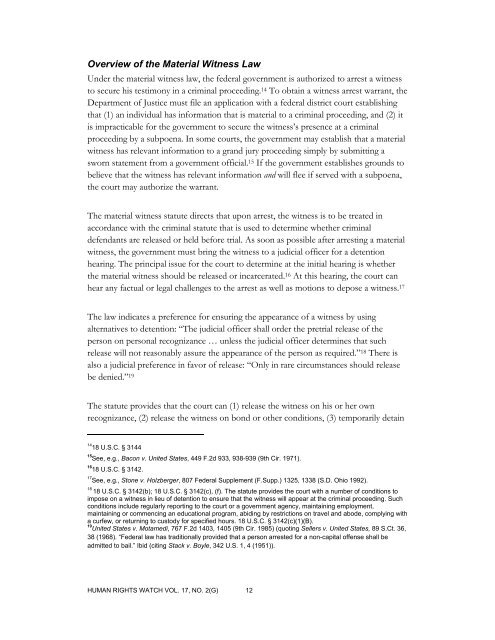Witness to Abuse - Human Rights Watch
Witness to Abuse - Human Rights Watch
Witness to Abuse - Human Rights Watch
Create successful ePaper yourself
Turn your PDF publications into a flip-book with our unique Google optimized e-Paper software.
Overview of the Material <strong>Witness</strong> Law<br />
Under the material witness law, the federal government is authorized <strong>to</strong> arrest a witness<br />
<strong>to</strong> secure his testimony in a criminal proceeding. 14 To obtain a witness arrest warrant, the<br />
Department of Justice must file an application with a federal district court establishing<br />
that (1) an individual has information that is material <strong>to</strong> a criminal proceeding, and (2) it<br />
is impracticable for the government <strong>to</strong> secure the witness’s presence at a criminal<br />
proceeding by a subpoena. In some courts, the government may establish that a material<br />
witness has relevant information <strong>to</strong> a grand jury proceeding simply by submitting a<br />
sworn statement from a government official. 15 If the government establishes grounds <strong>to</strong><br />
believe that the witness has relevant information and will flee if served with a subpoena,<br />
the court may authorize the warrant.<br />
The material witness statute directs that upon arrest, the witness is <strong>to</strong> be treated in<br />
accordance with the criminal statute that is used <strong>to</strong> determine whether criminal<br />
defendants are released or held before trial. As soon as possible after arresting a material<br />
witness, the government must bring the witness <strong>to</strong> a judicial officer for a detention<br />
hearing. The principal issue for the court <strong>to</strong> determine at the initial hearing is whether<br />
the material witness should be released or incarcerated. 16 At this hearing, the court can<br />
hear any factual or legal challenges <strong>to</strong> the arrest as well as motions <strong>to</strong> depose a witness. 17<br />
The law indicates a preference for ensuring the appearance of a witness by using<br />
alternatives <strong>to</strong> detention: “The judicial officer shall order the pretrial release of the<br />
person on personal recognizance … unless the judicial officer determines that such<br />
release will not reasonably assure the appearance of the person as required.” 18 There is<br />
also a judicial preference in favor of release: “Only in rare circumstances should release<br />
be denied.” 19<br />
The statute provides that the court can (1) release the witness on his or her own<br />
recognizance, (2) release the witness on bond or other conditions, (3) temporarily detain<br />
14<br />
18 U.S.C. § 3144<br />
15<br />
See, e.g., Bacon v. United States, 449 F.2d 933, 938-939 (9th Cir. 1971).<br />
16<br />
18 U.S.C. § 3142.<br />
17<br />
See, e.g., S<strong>to</strong>ne v. Holzberger, 807 Federal Supplement (F.Supp.) 1325, 1338 (S.D. Ohio 1992).<br />
18<br />
18 U.S.C. § 3142(b); 18 U.S.C. § 3142(c), (f). The statute provides the court with a number of conditions <strong>to</strong><br />
impose on a witness in lieu of detention <strong>to</strong> ensure that the witness will appear at the criminal proceeding. Such<br />
conditions include regularly reporting <strong>to</strong> the court or a government agency, maintaining employment,<br />
maintaining or commencing an educational program, abiding by restrictions on travel and abode, complying with<br />
a curfew, or returning <strong>to</strong> cus<strong>to</strong>dy for specified hours. 18 U.S.C. § 3142(c)(1)(B).<br />
19<br />
United States v. Motamedi, 767 F.2d 1403, 1405 (9th Cir. 1985) (quoting Sellers v. United States, 89 S.Ct. 36,<br />
38 (1968). “Federal law has traditionally provided that a person arrested for a non-capital offense shall be<br />
admitted <strong>to</strong> bail.” Ibid (citing Stack v. Boyle, 342 U.S. 1, 4 (1951)).<br />
HUMAN RIGHTS WATCH VOL. 17, NO. 2(G) 12
















